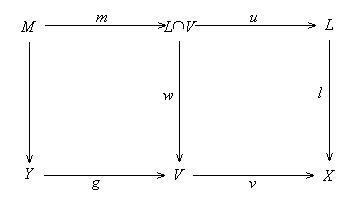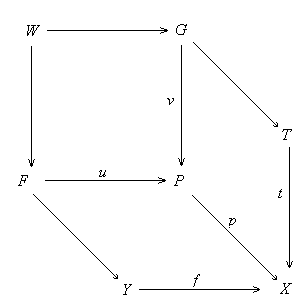|
Let A be a strict coherent analyitc geometires. Proposition 5.5.1. (a) Suppose W
Í X is a proper strong subobject.
There is a prime V of X such that the localization XV
is not contained in W.
Proof. Since any proper strong subobject is contained in a proper
regular subobject, and any proper regular subobject is an intersection
of proper finitely cogenerated regular subobjects by (4.1.3),
it suffices to prove the assertion for a proper finitely cogenerated regular
subobject W. First we note that there is a prime V of X
such that any analytic neighborhood U of V is not contained
in W. Otherwise W contains an analytic cover {Ui}
of X, which is not the case as the category is strict, therefore
X is the colimit of {Ui Ç
Uj}, and this only happens if X = W. Thus let V
be such a prime. The localization XV of X at V
is the cofiltered limit of all the analytic neighborhoods of V .
Assume XV is contained in W. Suppose W
is the equalizer of a pair (r1, r2): X
® T of maps with T finitely
copresentable. There is an open neighborhood u: U ®
X of V such that r1v = r2°v
(see the proof of (4.1.4)). Then V Í
U which contradicts to the choice of V. This shows
that XV is not contained in W.
Proposition 5.5.2. An object is reduced iff each of its localization is reduced. Proof. Suppose X is reduced. By (3.1.3.e)
analytic subobjects of X are reduced. Any localization of X
is a cofiltered limit of analytic subobjects of X, thus is reduced
by (5.1.5.b).
Proposition 5.5.3. A map f: Y ® X is epic iff its pullback along any localization of X is so. Proof. The pullback of any epi along a localization is epic as
any localization is coflat.
 n nProposition 5.5.4. Suppose f:
Y ® X is a mono.
Proof. (a) Suppose P Î Spec(Y)
and Q Î Spec(Y) are
two primes over the same O Î Spec(X).
Then their residues k(P) and k(Q) are
isomorphic to the residue k(O) of O by assumption.
Thus there are isomorphisms u: k(P) ®
k(O) and v: k(Q) ®
k(O). Let s (resp. t) be the compositions of
u-1: k(O) ®
k(P) (resp. v-1: k(O) ®
k(Q)) with the inclusions k(P) ®
Y (resp. k(Q) ®
Y ). Then f°s =
f°t is the inclusion
k(O) ® X. Since f
is a mono, we have s = t. So P = Q. This shows that Spec(f)
is injective.
Proposition 5.5.5. Suppose f:
Y ® X is a map.
Proof. (a) If Spec(f) is not surjective we can
find a residue P ® X which
does not factors through f, then P ®
X is disjoint with f, thus f is not unipotent.
 Proposition 5.5.6. Any unipotent local isomorphic mono f: Y ® X is an isomorphism. Proof. First note that Spec(f) is bijective by (5.5.4) and (5.5.5). Let Z be the coproducts of all localization lP: YP ® Y and let z: Z ® Y be the map induced by lP, then z is an epi by (5.5.1.b). Since f is a local isomorphism and Spec(f) is bijective, Z is also naturally the coproducts of localizations of X with f°z: Z ® X as the canonical map. Thus f°z is epic by (5.5.1.b), which implies that f is epic. Since finitely copresentable objects form a strong generating set of A, to see that f is an isomorphism, it suffices to prove that any map t: Y ® C from Y to a finitely copresentable object C factors through f. Suppose p: YP ® Y is a localization of Y at a prime P. Since f is a local isomorphism, f°p: YP ® X is the localization of X at f+1(P). Thus YP is the cofiltered limit of a collection of analytic neighborhoods Vi of f+1(P) with the maps (f°p)s: YP ® Vi. Since C is finitely copresentable, there exists an analytic neighborhood Vs of f+1(P) and a map gs: Vs ® C such that ts° ps = gs° fs° ps, where ts: f-1(Vs) ® C, ps: YP ® f-1(Vs) and fs: f-1(Vs) ® Vs are the induced maps. Since C is finitely copresentable and YP is the filtered limits of open analytic neighborhood of P, and f-1(Vs) is one of such analytic neighborhood, there is a small analytic neighborhood UP contained in f-1(Vs) such that the restrictions of ts and gs° fs on UP are the same, denoted this restriction by tP . We have proved that for any prime P we can find a small open neighborhood UP of P such that the restriction of t on UP can be factored through the restriction of f on UP. Since the analytic category is strict, these factorization can be glue together to obtain a global factorization for t by f. n Proposition 5.5.7. A mono is a local isomorphism iff it is a fraction. Proof. Suppose u: U ®
X is a local isomorphic mono. Any unipotent pullback of u is
a unipotent local isomorphic, therefore is an isomorphism by (5.5.6).
Thus u is normal. So we only need to prove that u is coflat.
Since the class of local isomorphisms is closed under pullback, it suffices
to prove that u is precoflat. Suppose t: T ®
X is an epi and r: Z ®
U, s: Z ® T is
the pullback of f and t. For any localization g:
G ® U the map r-1(U)
® U is epic because it is the
pullback of the epic map t along the localization u°g:
G ® X. This shows that if r
factors through a strong mono w: W Í
U, then W contains all the localization of U. This is
only possible if W = U by (5.5.1.a). This shows
that r is epic, which means that u is precoflat as
desired. The other direction has been proved in (5.3.3).
n
|